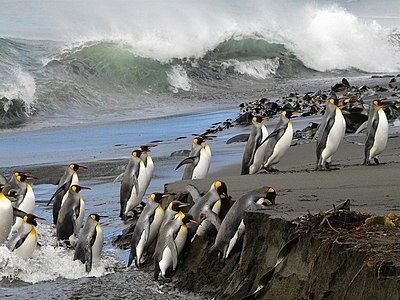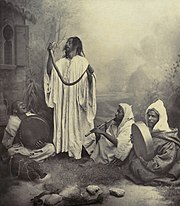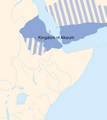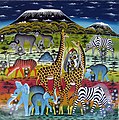
Back Portal:Afrika ALS بوابة:إفريقيا Arabic ܬܪܥܐ:ܐܦܪܝܩܐ ARC Portal:Afrika Azerbaijani Партал:Афрыка BE-X-OLD Портал:Африка Bulgarian دەروازە:ئەفریقا CKB Portál:Afrika Czech Portal:Afrika German Portal:Afrika DIQ

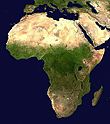

Africa is the world's second-largest and second-most populous continent after Asia. At about 30.3 million km2 (11.7 million square miles) including adjacent islands, it covers 20% of Earth's land area and 6% of its total surface area. With nearly 1.4 billion people as of 2021, it accounts for about 18% of the world's human population. Africa's population is the youngest among all the continents; the median age in 2012 was 19.7, when the worldwide median age was 30.4. Based on 2024 projections, Africa's population will reach 3.8 billion people by 2099. Africa is the least wealthy inhabited continent per capita and second-least wealthy by total wealth, ahead of Oceania. Scholars have attributed this to different factors including geography, climate, corruption, colonialism, the Cold War, and neocolonialism. Despite this low concentration of wealth, recent economic expansion and a large and young population make Africa an important economic market in the broader global context. Africa has a large quantity of natural resources resources, including diamonds, sugar, salt, gold, iron, cobalt, uranium, copper, bauxite, silver, petroleum, natural gas, cocoa beans, and.
Africa straddles the equator and the prime meridian. It is the only continent to stretch from the northern temperate to the southern temperate zones. The majority of the continent and its countries are in the Northern Hemisphere, with a substantial portion and a number of countries in the Southern Hemisphere. Most of the continent lies in the tropics, except for a large part of Western Sahara, Algeria, Libya and Egypt, the northern tip of Mauritania, and the entire territories of Morocco and Tunisia, which in turn are located above the tropic of Cancer, in the northern temperate zone. In the other extreme of the continent, southern Namibia, southern Botswana, great parts of South Africa, the entire territories of Lesotho and Eswatini and the southern tips of Mozambique and Madagascar are located below the tropic of Capricorn, in the southern temperate zone.
Africa is highly biodiverse; it is the continent with the largest number of megafauna species, as it was least affected by the extinction of the Pleistocene megafauna. However, Africa is also heavily affected by a wide range of environmental issues, including desertification, deforestation, water scarcity, and pollution. These entrenched environmental concerns are expected to worsen as climate change impacts Africa. The UN Intergovernmental Panel on Climate Change has identified Africa as the continent most vulnerable to climate change.
The history of Africa is long, complex, and varied, and has often been under-appreciated by the global historical community. In African societies the oral word is revered, and they have generally recorded their history via oral tradition, which has led anthropologists to term them "oral civilisations", contrasted with "literate civilisations" which pride the written word. During the colonial period, oral sources were deprecated by most historians, who claimed Africa had no history. African historiography became organized at the academic level in the mid-20th century, and saw a movement towards utilising oral sources in a multidisciplinary approach, culminating in the General History of Africa, edited by specialists from across the continent. (Full article...)
Selected article –
The Rwandan Civil War was a large-scale civil war in Rwanda which was fought between the Rwandan Armed Forces, representing the country's government, and the rebel Rwandan Patriotic Front (RPF) from 1 October 1990 to 18 July 1994. The war arose from the long-running dispute between the Hutu and Tutsi groups within the Rwandan population. The Rwandan Revolution, which broke out in 1959, had replaced the Tutsi monarchy with a Hutu-led republic, forcing more than 336,000 Tutsis to seek refuge in neighbouring countries. A group of these refugees in Uganda founded the RPF which, under the leadership of Fred Rwigyema and Paul Kagame, became a battle-ready army by the late 1980s.
The war began on 1 October 1990, when the RPF invaded north-eastern Rwanda, advancing 60 km (37 mi) into the country. They suffered a major setback when Rwigyema was killed in action on the second day. The Rwandan Army, assisted by expeditionary troops from France, gained the upper hand and the RPF were largely defeated by the end of October. Kagame, who had been in the United States during the invasion, returned to take command. He withdrew troops to the Virunga Mountains for several months before attacking again. The RPF began an insurgency, which continued until mid-1992 with neither side able to gain the upper hand. A series of protests forced Rwandan President Juvénal Habyarimana to begin peace negotiations with the RPF and domestic opposition parties. Despite disruption and killings by Hutu Power, a group of extremists opposed to any deal, and a fresh RPF offensive in early 1993, the negotiations were successfully concluded with the signing of the Arusha Accords in August 1993. (Full article...)
Featured pictures –
Did you know (auto-generated) -

- ... that in 2019 the South African army's Natal Carbineers were renamed the Ingobamakhosi Carbineers, after a Zulu regiment that had fought against them at the 1879 Battle of Isandlwana?
- ... that land for a library built for African Americans in Virginia was donated by Pope Pius XII?
- ... that Kenyan coffee farmer "Pinkie" Jackson amassed Africa's largest collection of native butterflies?
- ... that Rachel Belden Brooks was an African-American pioneer who was awarded $1,000 when she sued the estate of her previous enslaver?
- ... that British communist leader Trevor Carter was the stage manager for the first British-Caribbean carnival, held in St Pancras Town Hall?
- ... that Bea Hines, the first African-American woman to become a reporter at the Miami Herald, was sent to report on a riot on her first day at work?
Categories
Selected biography –
Thomas Joseph Odhiambo Mboya (15 August 1930 – 5 July 1969) was a Kenyan trade unionist, educator, Pan-Africanist, author, independence activist, and statesman. He was one of the founding fathers of the Republic of Kenya. He led the negotiations for independence at the Lancaster House Conferences and was instrumental in the formation of Kenya's independence party – the Kenya African National Union (KANU) – where he served as its first Secretary-General. He laid the foundation for Kenya's capitalist and mixed economy policies at the height of the Cold War and set up several of the country's key labour institutions. Mboya was Minister for Economic Planning and Development when he was assassinated.
Mboya's intelligence, charm, leadership, and oratory skills won him admiration from all over the world. He gave speeches, participated in debates and interviews across the world in favour of Kenya's independence from British colonial rule. He also spoke at several rallies in the goodwill of the Civil Rights movement in the United States. In 1958, at the age of 28, Mboya was elected Conference Chairman at the All-African Peoples' Conference convened by Kwame Nkrumah of Ghana. He helped build the Trade Union Movement in Kenya, Uganda and Tanzania, as well as across Africa. He also served as the Africa Representative to the International Confederation of Free Trade Unions (ICFTU). In 1959, Mboya called a conference in Lagos, Nigeria, to form the first All-Africa ICFTU labour organization. (Full article...)
Selected country –
 |
||

| ||
Libya (Arabic: ليبيا Lībiyā), officially the State of Libya, is a country in North Africa. Bordering the Mediterranean Sea to the north, Libya lies between Egypt to the east, Sudan to the southeast, Chad and Niger to the south, and Algeria and Tunisia to the west. With an area of almost 1.8 million square kilometres (700,000 sq mi), 90% of which is desert, Libya is the fourth largest country in Africa by area, and the seventeenth largest in the world. The capital, Tripoli, is also Libya's largest city. The three traditional parts of the country are Tripolitania, the Fezzan and Cyrenaica.
Libya was ruled by Muammar Gaddafi under the Great Socialist People's Libyan Arab Jamahiriya for 42 years before he was overthrown and killed by rebel forces during the 2011 Libyan civil war. From 2014 to 2020 the country endured a second civil war between rival governments based in Tripoli and Tobruk. The Libyan economy has historically depended primarily upon revenues from the oil sector, and under Gaddafi's government these oil revenues combined with a small population gave Libya one of the highest GDPs per person in Africa. (Read more...)
Selected city –
Tindouf (Arabic: تندوف, romanized: Tindūf) is the main town, and a commune in Tindouf Province, Algeria, close to the Mauritanian, Western Saharan and Moroccan borders. The commune has a population of around 160,000, but the census and population estimates do not count the Sahrawi refugees, making the population as of the 2008 census 45,966, up from 25,266 in 1998, giving the town an annual population growth rate of 6.3%.
The region is considered of strategic significance as it houses Algerian military bases and an airport with regular flights to Algiers, as well as flights to other domestic destinations. The settlement of Garet Djebilet lies within the municipal territory of Tindouf near the border with Mauritania; the settlement has an iron mine and a defunct airport, and is approximately 70 kilometres (43 mi) northwest of Âouinet Bel Egrâ. Since 1975, it also contains several Sahrawi refugee camps operated by the Polisario Front, a national liberation movement seeking the self-determination of Western Sahara. (Full article...)
In the news
- 6 March 2025 – Somali civil war
- Turkish Airlines and Qatar Airways temporarily suspend flights to Aden Adde International Airport in Mogadishu, Somalia, following security warnings from the United States embassy about potential terrorist attacks targeting the airport. (Aero Time) (Hiiraan Online)
- 6 March 2025 – Sudanese civil war
- The government of Sudan files a lawsuit in the International Court of Justice against the United Arab Emirates for its alleged support of the Rapid Support Forces and its complicity in genocide against the Masalit people in Darfur, Sudan. The UAE denies its involvement in Sudan and calls the lawsuit a "publicity stunt". (Middle East Eye) (Al Jazeera)
- 5 March 2025 – South Sudanese Civil War
- 2025 Nasir clashes
- Security forces in South Sudan arrest Puot Kang Chol, a senior member of the parliamentary opposition, minister of petroleum and mining, and army general, as well as multiple other opposition-aligned military officers. South Sudanese soldiers also surround vice president Riek Machar's house overnight before later withdrawing. (Reuters) (BBC News)
- 5 March 2025 – Somalia–United States relations
- The U.S. Embassy in Mogadishu warns of imminent attack threats in Somalia, including at Aden Adde International Airport. Embassy personnel movements are suspended. (ABC News)
- Somali military officials confirm that the Trump administration has halted all funding for Somalia's Danab Brigade special forces and cut billions in USAID grants to the country. (Hiiraan Online)
Updated: 22:05, 6 March 2025
General images -
Africa topics
More did you know –
- ...that Iyabo Obasanjo-Bello, a Nigerian Senator from the People's Democratic Party, is the daughter of former President Olusegun Obasanjo?
- ...that the 2007 South Africa miners' strike, which impacted over 240,000 workers, was the first ever industry-wide miners' strike in the history of South Africa?
- ...that Seleh Leha, a town in Tigray Region in northern Ethiopia, was the site of a leprosarium built during the Italian occupation of East Africa and abandoned in 1941?
- ...that Sarir field, an oil field in Cyrenaica operated by the Arabian Gulf Oil Company (AGOCO), is considered to be the largest in Libya, with estimated oil reserves of 12 Gbbl (1.9×109 m3)?
Related portals
Major Religions in Africa
North Africa
West Africa
Central Africa
East Africa
Southern Africa
Associated Wikimedia
The following Wikimedia Foundation sister projects provide more on this subject:
-
Commons
Free media repository -
Wikibooks
Free textbooks and manuals -
Wikidata
Free knowledge base -
Wikinews
Free-content news -
Wikiquote
Collection of quotations -
Wikisource
Free-content library -
Wikispecies
Directory of species -
Wikiversity
Free learning tools -
Wikivoyage
Free travel guide -
Wiktionary
Dictionary and thesaurus








